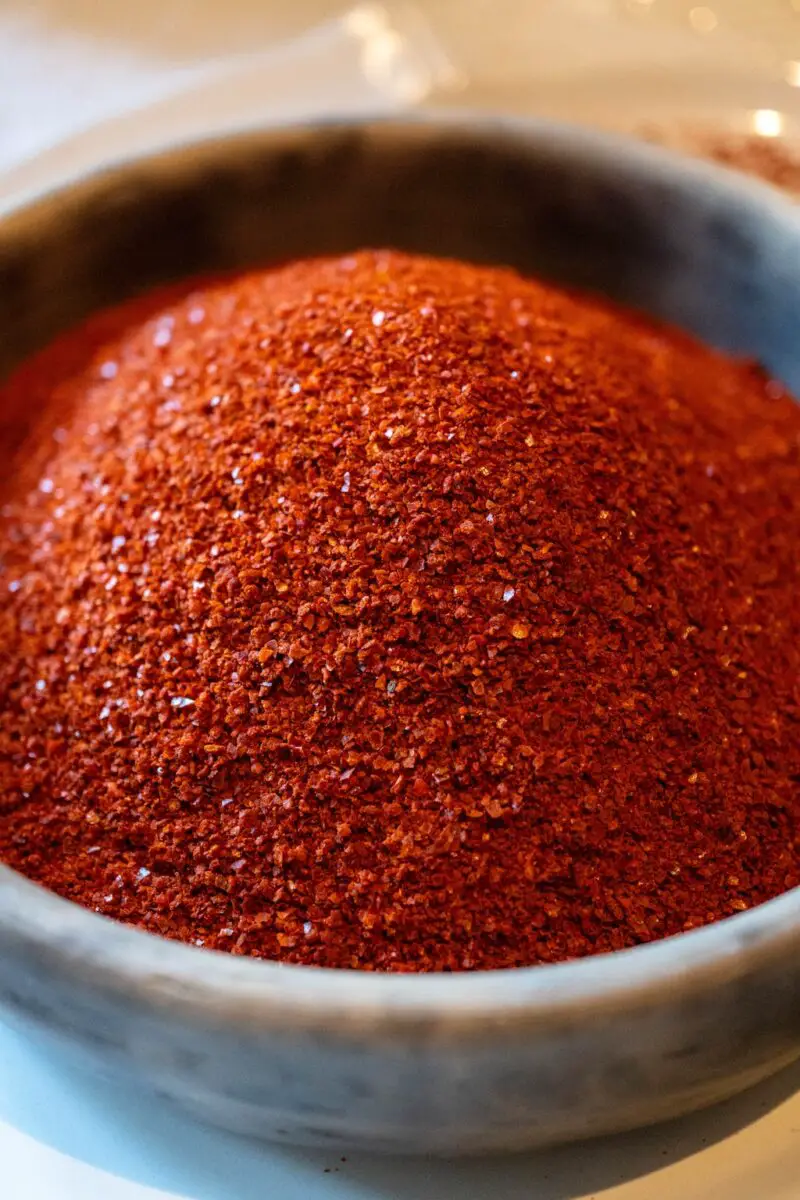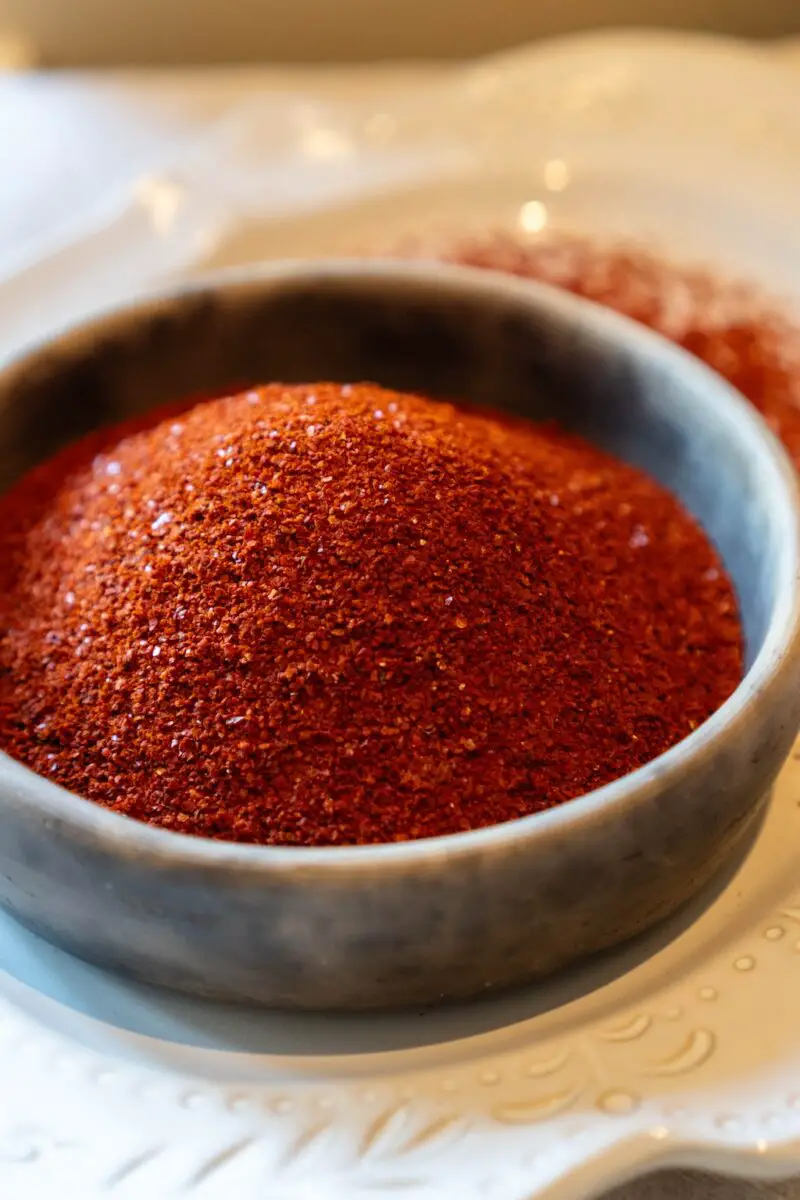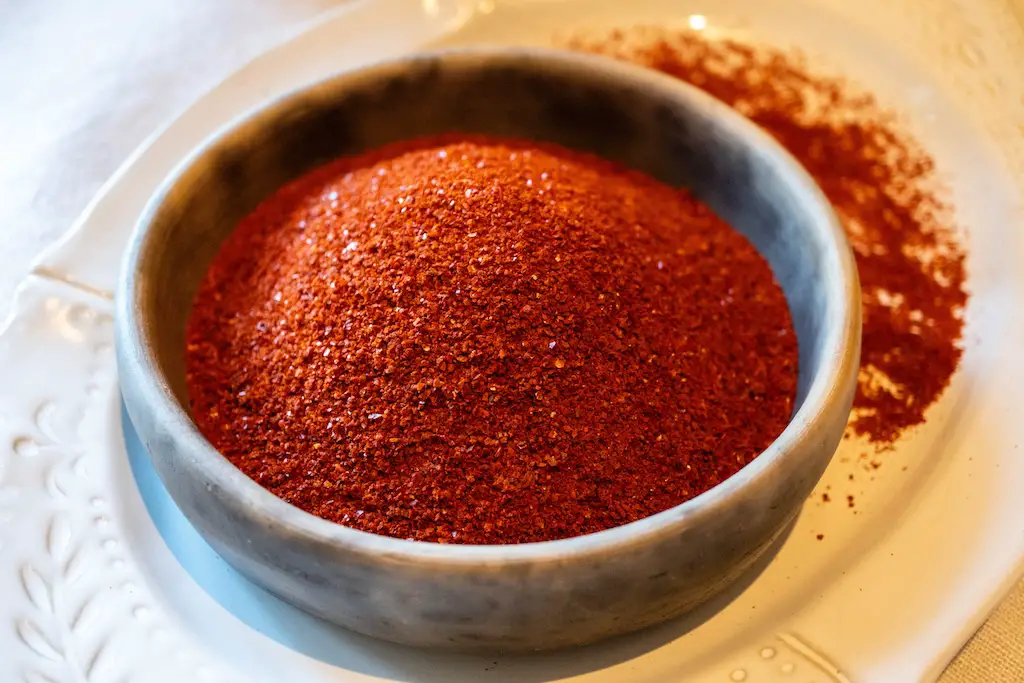This post may contain affiliate links. Please read my disclosure for details at the bottom of this page. As an Amazon Associate, I earn from qualifying purchases on this Korean gochugaru (Korean red pepper flakes) ingredient article!
Published 09/09/2021 Updated 02/22/2024
Gochugaru, also known as Korean red pepper flakes or Korean red pepper powder, is a type of ground spice used in Korean cuisine. This Korean spice has a unique and complex spicy, slightly sweet, and smokey flavor profile.
The word ‘gochugaru’ (고춧가루) derives from ‘gochu’ (고추) meaning ‘chili pepper’ and ‘garu’ (가루) meaning ‘powder.’ This vibrant ingredient helps to give many Korean dishes their famous red coloring as well as their flavor.
Here, we will go over information about Korean chili peppers and gochugaru as well as information about which type of gochugaru to buy based on the dish being cooked.
About the Korean Chili Pepper:
As I stated above, in Korea, the word ‘gochu’ (고추) means ‘chili pepper.’
When using this word, people in South Korea are referring to a specific type of Korean chili pepper which comes in both green and red varieties. Otherwise, they refer to a type of peppers by their names–for example, people use the word ‘할라피뇨’ for ‘jalapeño.’ This word is pronounced the same as the Spanish equivalent ‘jalapeño’ but with Korean accentuation.
Though chili peppers are now an integral part of Korean culture, they were not native to the peninsula. The chili pepper originated in the Americas. During the 16th century, the Portuguese introduced it to Korea through Japan–The earliest known mention of peppers in Korean recorded history is from an encyclopedia published in 1614 titled Collected Essays of Jibong. Since then, the use of peppers in Korean food has expanded. Now, their food culture heavily relies on them.
Fun Fact:
Originally, kimchi did not contain red pepper flakes or powder. Kimchi dates back thousands of years. The use of red peppers in Korean cuisine only dates back approximately 400 years.

Types of Korean Chili Peppers:
- ‘Put-Gochu’ (풋고추): Green Chili Peppers. These peppers are also known as Korean dark green or Korean long green peppers. This chili pepper is medium-sized, long, and slim. Typically, this variety of pepper has a mild flavor with a tiny bit of heat. The green pepper comes from the same plant as the Korean red pepper, though they are distinguished in Korean food culture. The Korean green pepper is picked at an earlier stage of the ripening process.
- ‘Hong-Gochu’ (홍고추): Red Chili Peppers. These peppers are also known as Korean red or Korean long red peppers. These peppers are also long and slim, though they are a bit spicier than the green peppers. Unlike ‘put-gochu,’ these are allowed to fully ripen before being picked.
- ‘Cheongyang-Gochu’ (청양고추): Cheongyang Pepper. This chili pepper is a medium-sized variety that looks similar to Korean green and red chili peppers. Though they look similar, these peppers are MUCH spicier. The Cheongyang pepper was first developed by Dr. Yoo Il-Woong by hybridizing the local Jeju Island Korean chili with Thai chili. You can learn more about the Cheongyang pepper via my ingredient article on the subject.
Types of Red Pepper Powder:
When cooking Korean food, you need to pick the proper type of pepper powder based on the dish you are preparing. First, you need to pick the level of grind of the gochugaru. Second, you need to pick the spice level.
Korean Red Pepper Flakes vs Powder:
As I stated above, you need to first pick the level of the gochugaru grind. Typically, you will find two levels. First, people finely ground the peppers (powder). Alternatively, people also coarsely ground the peppers (flakes):
- Finely Ground (Red Pepper Powder): You can use Korean red pepper powder to make many dishes including gochujang, a type of fermented red pepper paste.
- Coarsely Ground (Red Pepper Flakes): You can use Korean red pepper flakes for other types of dishes. For example, you use this version to make soups, stews, stir-fried dishes, and more!
Note: Unfortunately, because of a lack of proper translation, many bags of important gochugaru are not labeled properly as powder or flakes. Thankfully, you can often see the contents of the bags when shopping through a clear plastic section next to the label. Always check to make sure you are buying the proper grind level!

Spice Level:
In Korea, people also distinguish gochugaru based on the level of spice. Typically you can find milder and spicier versions. The spice level is based on the region it is grown, the annual climate, and the cultivation. Once you fall in love with a certain spice level and brand, you can consistently rely on them when purchasing more gochugaru.
If you want really, really spicy gochugaru, look for ones made from the Cheongyang pepper. This variation often has a darker color than the Korean red pepper alternatives.
Korean Gochugaru Frequently Asked Questions:
Below, I list some questions you may have about Korean gochugaru. If I do not answer your question below, feel free to leave a comment or email me at [email protected]!
How Long Can You Keep Gochugaru?
After opening, I recommend placing the package of gochugaru in an airtight container in the refrigerator. If you aren’t going to use it within a few weeks, you can store gochugaru in the freezer for up to six months.
Once bad, the color changes from red (it can range from a vibrant red to dark red) to brown or yellow.
Can You Substitute Korean Gochugaru?
Unfortunately, gochugaru has a unique flavor that cannot be replicated with other types of peppers. If you cannot find gochugaru, try using paprika or chili powder. While it won’t taste authentic or nearly as delicious, your dish will still taste good.

What Type of Brand Should I Buy?
As I stated above, I recommend buying gochugaru based on your desired spice level. For that reason, I will not recommend a specific brand for all eaters.
That being said, I recommend everyone buy gochugaru grown and processed in South Korea. Many brands you can find outside of Korea (though they have Korean labels) sell gochugaru grown in other countries like China. Unfortunately, South Korean brands that only use Korean-grown peppers often cost more than their alternatives. If price matters more to you, you can save some money by buying the cheaper option. You can typically find where the peppers are grown on the back and bottom of a package.
I Hope You Enjoyed Learning About Korean Gochugaru!
In the end, I hope you enjoyed learning about Korean gochugaru. If so, let me know in the comment section below. Also, if you cook with Korean red pepper powder, what do you typically make?
If you would like to read more about cooking, you can find further recipes on this blog. I listed some of my favorite Carving A Journey recipes below! For reference, many recipes are influenced by my family’s blended Korean and Southern heritage.
Further Korean Ingredient Articles:
Further Korean Recipes:
- Greek Momo Recipe (Korean Breakfast Trend)
- Jumeokbap (Handmade Korean Rice Balls); And
- Bibimmyeon (Korean Spicy Cold Noodles)
If you have any questions or comments, you can also email me at [email protected]. And, finally, I would love to hear from you through our social media as well! You can follow me at @carvingajourney on Instagram, Facebook, and Pinterest. I also started a vlog YouTube channel with my husband! Or, if you would like more articles like these, you can subscribe to the blog by joining the mailing list. Let me know if you try cooking with Korean red pepper powder (aka gochugaru). Thank you so much for stopping by!
Carving A Journey is a participant in the Amazon Services LLC Associates Program, an affiliate advertising program designed to provide a means for sites to earn advertising fees by advertising and linking to Amazon.com. Although we may earn commissions for our endorsement, recommendation, testimonial, and/or link to any products or services from this website, these opinions are my own and I fully support these products.

